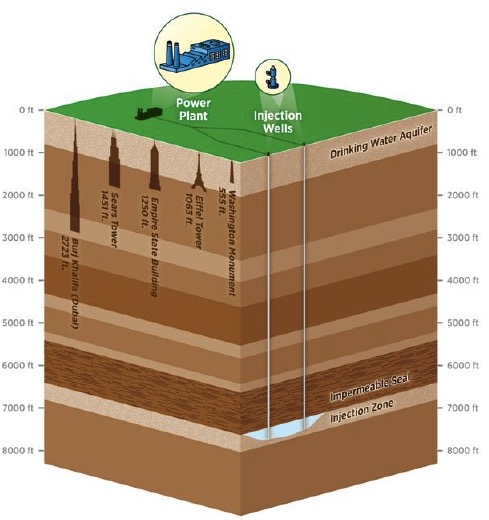Environmental impact - global warming

 C.5 Environmental impact - global warming (3 hours)
C.5 Environmental impact - global warming (3 hours)
Pause for thought
In August 2015 President Obama announced a Clean Power Plan for the US. This introduces, for the first time, national standards to limit carbon pollution from power plants. By the year 2030 the plan aims to reduce carbon dioxide emissions from their 2005 levels by 32 percent. Energy efficiency, energy conservation and switching to sustainable non-carbon energy sources all form part of the plan. Realistically, however, fossils fuels are still an important energy source so much of the emphasis will be on reducing the carbon dioxide emissions from the power stations to the atmosphere. This will be done by improved carbon capture and sequestration.
Carbon capture (really carbon dioxide capture) can be done pre-combustion, post-combustion or by oxyfuel combustion. In the pre-combustion process the fossil fuel is partially oxidised to form syngas, a mixture of carbon monoxide and hydrogen. This is converted into carbon dioxide and hydrogen and the carbon dioxide removed before the hydrogen is burned as a fuel. The oxyfuel combustion involves burning the fossil fuel in oxygen rather than air so that complete combustion occurs to give nearly pure carbon dioxide and water from which the water can be removed by cooling. The captured carbon is then transported (usually through pipes in the form of compressed carbon dioxide) to sites where it can be geologically sequestrated by injecting it into porous rocks more than a mile underground. The carbon dioxide is trapped in these porous rocks as the layers above comprise of impermeable non-porous rocks.

Sequestration (Image from United States Environmental Protection Agency)
![]() Carbon sequestration - The National Energy Technology lab
Carbon sequestration - The National Energy Technology lab
Nature of science
The study of global warming is transdisciplinary and involves a wide range of concepts and ideas.
The work of the Intergovernmental Panel on Climate Change (IPCC) involves collaboration and the explanation of science to the public.
There is a clear correlation between carbon dioxide levels and the average temperature of the Earth, although wide variations in the Earth's surface temperature have occurred frequently in the past.
Learning outcomesAfter studying this topic students should be able to: Understand:
Apply their knowledge to:
| Clarification notesThe greenhouse gases to be considered are methane, water and carbon dioxide. International-mindednessGlobal warming involves The international community is working together to research and reduce the effects of global warming. Such attempts include the Intergovernmental Panel on Climate Change (IPCC) and the 1997 Kyoto Protocol which came into force in 2005 and was later was amended and extended in Doha, Qatar in 2012 and in Paris in 2016. Agreement on how it can be implemented was reached at Katowice in 2018. |
Teaching tipsYou will need to ensure that your students can explain fully what the greenhouse effect is and how greenhouse gases contribute to global warming. When this option was part an older programme many students confused radiated light with reflected light when answering examination questions. They also need to understand that gases like oxygen and nitrogen do not absorb infrared radiation even though their bonds still vibrate as the vibrations do not involve a change in dipole moment. The guidance section of the syllabus limits the greenhouse gases just to water, carbon dioxide and methane but students should be aware that other gases, such as CFCs, ozone and sulfur hexafluoride, have the potential to cause much greater global warming but their concentration in the atmosphere is much lower. The three main ways in which greenhouse gas emission can be reduced are :
The ocean can absorb some of the increases in carbon dioxide but this decreases the pH, which leads to the destruction of coral reefs. | Study GuidePage 147 QuestionsFor ten 'quiz' questions (for quick testing of knowledge and understanding with the answers explained) see MC test: Environmental impact – global warming. For short-answer questions see Environmental impact - global warming questions together with the worked answers on a separate page Environmental impact - global warming answers. Vocabulary listgreenhouse gas |
Teaching slides
Teachers may wish to share these slides with students for learning or for reviewing key concepts.
Other resources
1. A good three minute animated video explaining how greenhouses gases work which covers most of the main facts (although only talks about 'lopsided' rather than 'change in dipole moment') from MinuteEarth.
![]() How do greenhouse gases actually work?
How do greenhouse gases actually work?
2 - 8. A series of seven short videos by the National Research Council presenting the evidence that greenhouse gases do affect climate .

 IB Docs (2) Team
IB Docs (2) Team 



















